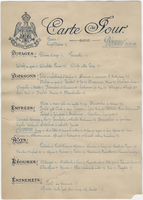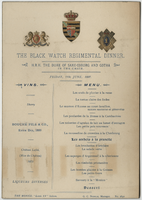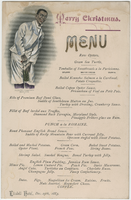Search the Special Collections and Archives Portal
Search Results

Savoy Hotel, lunch menu, October 29, 1898
Date
Archival Collection
Description
Text

Menu for the Black Watch Regimental dinner, Friday, June 11, 1897, The Monico Louis XV saloon
Date
Archival Collection
Description
Text

Christmas menu, December 25, 1883, Lindell Hotel
Date
Archival Collection
Description
Text
Citizen Alert Records
Identifier
Abstract
Citizen Alert is a Nevada-based environmental organization established in 1975 in response to Yucca Mountain being considered as the repository for the nation's nuclear waste. The records in the collection date from 1971-1999, with the bulk of the records from 1988-1996 and focused on issues of concern to Southern Nevada. The collection includes a large subject and administration file containing the organization’s mailings, fliers and newsletters regarding environmental issues and events, newsletters of other environmental organizations, press releases and brochures from a number of government agencies, and newspaper clippings on specific environmental topics. The collection also contains a number of environmental reports from federal, state, and local agencies as well as a number of conference and activist packets.
Archival Collection
Jack Schofield Papers
Identifier
Abstract
The Jack Schofield Papers are comprised of Dr. Jack Lund Schofield's scrapbooks, photographs, and awards from 1968 to 2014. Dr. Schofield was a Nevada System of Higher Education (NSHE) regent, member of the Nevada legislature, and teacher. The scrapbooks document Schofield's involvement with the University of Nevada, Las Vegas (UNLV) Aerospace program from the 1960s to the 1990s. The awards and photographs are from NSHE and document Schofield's involvement as a regent.
Archival Collection
UNLV Libraries Collection on Claes Oldenburg's Flashlight Sculpture
Identifier
Abstract
The UNLV Libraries Collection on Claes Oldenburg's
Archival Collection
Hank Castro Music Business Records and Audio Recordings
Identifier
Abstract
The Hank Castro Music Business Records document Hank Castro's career in the music industry in Las Vegas, Nevada from 1969 to 1990. The bulk of the collection consists of original audio recordings from the Las Vegas Recording Studio. The collection also contains legal documents, personal correspondence, and promotional material related to the Las Vegas Recording Studio (1971-1985), songwriter agreements, and sheet music (the majority of the lyrics written by Hank Castro) from artists represented by the Las Vegas Recording Studio and Castro's other companies.
Archival Collection
Kim Sisters Scrapbooks and Clippings
Identifier
Abstract
The Kim Sisters material date from 1959 to 1966 and 1983. It consists of two scrapbooks and one folder of photocopied materials containing newspaper clippings about the appearances of the Kim Sisters muscial group throughout the United States as well as Italy, Germany, and Spain. It also includes two record album sleeves.
Archival Collection
Richard W. Bunker oral history interviews
Identifier
Abstract
Oral history interviews with Richard W. Bunker conducted by Stefani Evans and Claytee D. White on July 18 2017, July 21, 2017, and September 28, 2017 for the Building Las Vegas Oral History Project. In this interview, Bunker discusses the history behind a wide range of events that affected the daily lives of Southern Nevadans. He talks about his role in a consolidation attempt between the Clark County and Las Vegas, Nevada governmental structures that was halted by the courts in 1975. Bunker then recalls working as a member and Chair of the Nevada Gaming Control Board and his work with various casinos and hotels including Circus Circus, the Dunes, and the Aladdin. He discusses replacing key people at the Gaming Control Board, and the Federal Bureau of Investigation’s (FBI) Operation Yobo sting. He then speaks fondly of his longtime friends Jim Gibson, Judge Lloyd George, and Jim Joyce. Lastly, Bunker discusses water rights, supply, and management issues in Nevada as it relates to the Nevada Resort Association, Las Vegas Valley Water District, Southern Nevada Water Authority, and the Colorado River Commission.
Archival Collection
Ann Valder Photograph Collection on Judy Bayley
Identifier
Abstract
The Ann Valder Photograph Collection on Judy Bayley (1969-1971) consists of black-and-white photographic prints of Hacienda Hotel owner Judy Bayley, collected by Las Vegas, Nevada journalist Ann Valder. The collection is primarily comprised of photographic prints of Bayley at a 1971 event held in her honor at the International Hotel in Las Vegas, Nevada. The collection also includes photographic prints of Bayley at fundraisers for the American Cancer Society. Ann Valder was an editor and journalist for the
Archival Collection
